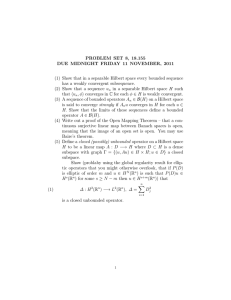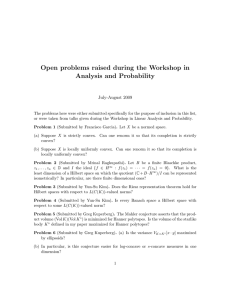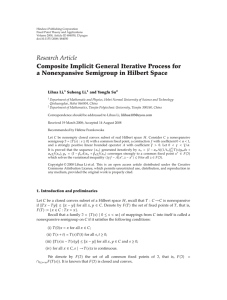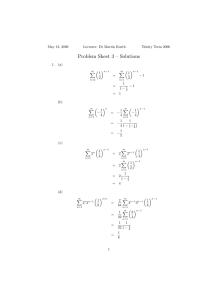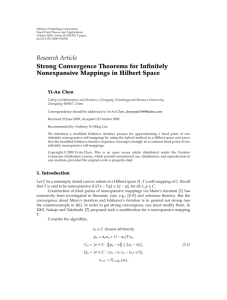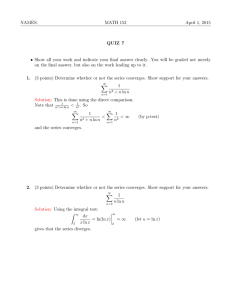Document 10941705
advertisement
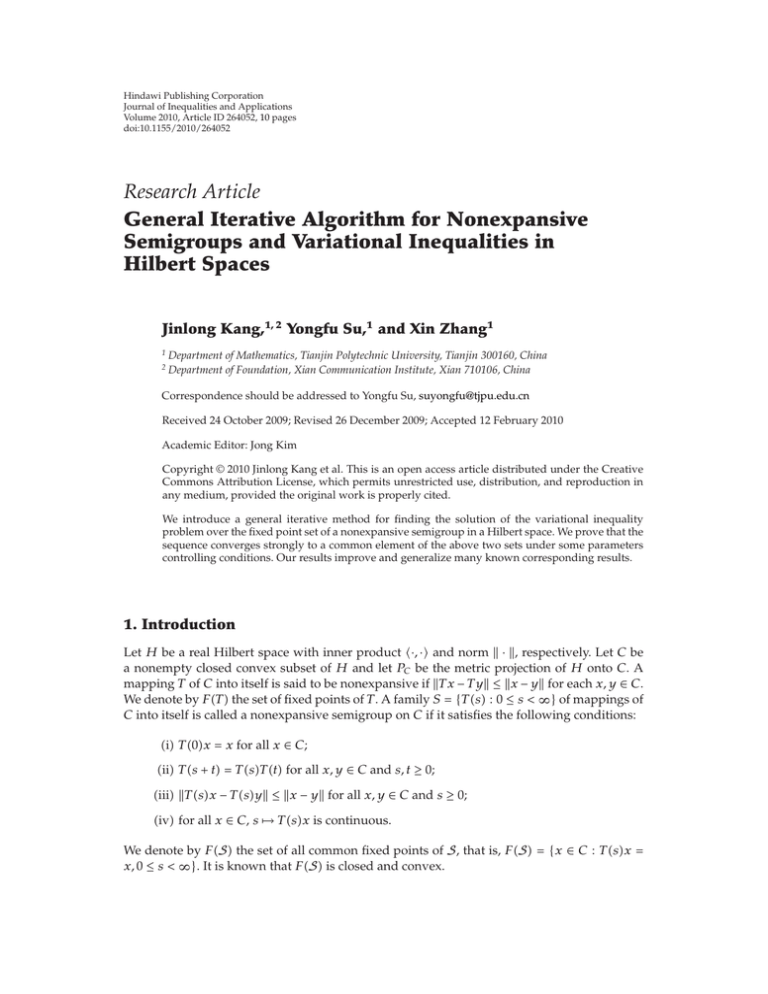
Hindawi Publishing Corporation
Journal of Inequalities and Applications
Volume 2010, Article ID 264052, 10 pages
doi:10.1155/2010/264052
Research Article
General Iterative Algorithm for Nonexpansive
Semigroups and Variational Inequalities in
Hilbert Spaces
Jinlong Kang,1, 2 Yongfu Su,1 and Xin Zhang1
1
2
Department of Mathematics, Tianjin Polytechnic University, Tianjin 300160, China
Department of Foundation, Xian Communication Institute, Xian 710106, China
Correspondence should be addressed to Yongfu Su, suyongfu@tjpu.edu.cn
Received 24 October 2009; Revised 26 December 2009; Accepted 12 February 2010
Academic Editor: Jong Kim
Copyright q 2010 Jinlong Kang et al. This is an open access article distributed under the Creative
Commons Attribution License, which permits unrestricted use, distribution, and reproduction in
any medium, provided the original work is properly cited.
We introduce a general iterative method for finding the solution of the variational inequality
problem over the fixed point set of a nonexpansive semigroup in a Hilbert space. We prove that the
sequence converges strongly to a common element of the above two sets under some parameters
controlling conditions. Our results improve and generalize many known corresponding results.
1. Introduction
Let H be a real Hilbert space with inner product ·, · and norm · , respectively. Let C be
a nonempty closed convex subset of H and let PC be the metric projection of H onto C. A
mapping T of C into itself is said to be nonexpansive if T x − T y ≤ x − y for each x, y ∈ C.
We denote by FT the set of fixed points of T . A family S {T s : 0 ≤ s < ∞} of mappings of
C into itself is called a nonexpansive semigroup on C if it satisfies the following conditions:
i T 0x x for all x ∈ C;
ii T s t T sT t for all x, y ∈ C and s, t ≥ 0;
iii T sx − T sy ≤ x − y for all x, y ∈ C and s ≥ 0;
iv for all x ∈ C, s → T sx is continuous.
We denote by FS the set of all common fixed points of S, that is, FS {x ∈ C : T sx x, 0 ≤ s < ∞}. It is known that FS is closed and convex.
2
Journal of Inequalities and Applications
Let A be a strongly positive bounded linear operator on H: that is, there is a constant
γ with property
Ax, x ≥ γx2
1.1
∀x ∈ H.
A typical problem is to minimize a quadratic function over the set of the fixed points
of a nonexpansive mapping on a real Hilbert space H:
1
min Ax, x − x, b,
x∈K 2
1.2
where K is the fixed point set of a nonexpansive mapping T on H and b is a given point in
H. In 2001, Yamada 1 presented the hybrid steepest descent method for problem 1.2. In
2003, Xu 2 proved that the sequence {xn } defined by the iterative method below, with the
initial guess x0 ∈ H, chosen arbitrarily:
xn1 αn b I − αn AT xn ,
n≥0
1.3
converges strongly to the unique solution of the minimization problem 1.2 provided the
sequence {αn } satisfies certain conditions.
On the other hand, Moudafi 3 introduced the viscosity approximation method
for nonexpansive mappings see 4 for further developments in both Hilbert and Banach
spaces. Let f be a contraction on H such that fx − fy ≤ αx − y, where α ∈ 0, 1 is a
constant. Starting with an arbitrary initial x0 ∈ H, define a sequence {xn } recursively by
xn1 βn fxn 1 − βn T xn ,
n ≥ 0,
1.4
where {βn } is a sequence in 0, 1. It is proved 3, 4 that under certain appropriate conditions
imposed on {βn }, the sequence {xn } generated by 1.4 converges strongly to the unique
solution x in K of the variational inequality
I − f x,
x − x ≥ 0,
x ∈ K.
1.5
Recently, Marino and Xu 5 combine the iterative method 1.3 with the viscosity
approximation 1.4 and consider the following general iterative method:
xn1 αn γfxn I − αn AT xn ,
n ≥ 0.
1.6
Journal of Inequalities and Applications
3
They proved that if the sequence {αn } of parameters satisfies appropriate conditions,
then the sequence {xn } generated by 1.6 converges strongly to the unique solution of the
variational inequality
A − γf x,
x − x
≥ 0,
x ∈ FT ,
1.7
which is the optimality condition for the minimization problem
1
min Ax, x − hx,
x∈K 2
1.8
where h is a potential function for γf i.e., h x γf for x ∈ H.
Note that I − f and A − γf in problems 1.5 and 1.7 are strongly monotone and
Lipschitz continuous. Therefore, problems 1.5 and 1.7 can be solved by 1, 7, 8. In 7, 8,
algorithms to accelerate the hybrid steepest descent method have been proposed.
Quite recently, for the nonexpansive semigroups S {T s : 0 ≤ s < ∞}, Plubtieng
and Punpaeng 9 study the iteration process {xn } defined by
xn1
1
αn fxn βn xn 1 − αn − βn
sn
sn
T sxn ds,
n ≥ 0,
1.9
0
where x0 ∈ C, {αn },{βn } are two sequences in 0, 1, and {sn } is a positive real divergent real
sequence and prove a strong convergence theorem.
In this paper, motivated and inspired by the above results, we prove a strong
convergence of the iterative scheme in a real Hilbert space by
xn1 αn γfxn βn xn 1
1 − βn I − αn A
sn
sn
T sxn ds,
n ≥ 0.
1.10
0
Furthermore, we show that if the sequences {αn } and {βn } of parameters satisfy appropriate
conditions, then the sequence {xn } converges strongly to the unique solution of the
variational inequality
A − γf x,
x − x ≥ 0,
x ∈ FT ,
1.11
which is the optimality condition for the minimization problem
min
1
x∈FT 2
Ax, x − hx,
1.12
where h is a potential function for γf i.e., h x γf for x ∈ H. The results of this paper
extended and improved the results of Xu 2, Moudafi 3, Marino and Xu 5, and Plubtieng
and Punpaeng 9.
4
Journal of Inequalities and Applications
2. Preliminaries
Recall that given a closed convex subset K of a real Hilbert space H, the nearest point
projection PK from H onto K assigns to each x ∈ H its nearest point denoted by PK x in
K from x to K; that is, PK x is the unique point in K with the property
x − PK x ≤ x − y
∀y ∈ K.
2.1
The following Lemmas 2.1 and 2.2 are well known.
Lemma 2.1. Let K be a closed convex subset of a real Hilbert space H.Given x ∈ H and z ∈ K. Then
z PK x if and only if there holds the following relation:
x − z, y − z ≤ 0 ∀y ∈ K.
2.2
Lemma 2.2. Let H be a real Hilbert space. There hold the following identities.
i x y2 ≤ x2 2y, x y, ∀x, y ∈ H.
ii tx 1 − ty2 tx2 1 − ty2 − t1 − tx − y2 ∀x, y ∈ H, t ∈ 0, 1.
Definition 2.3 Opial’s condition 10. A space X is said to satisfy Opial’s condition if for each
sequence {xn }∞
n1 in X which converges weakly to point x ∈ X, we have
lim infxn − x < lim infxn − y,
n→∞
n→∞
∀y ∈ X, y / x.
2.3
It is well known that Hilbert spaces satisfy Opial’s condition.
Lemma 2.4 Browder 6. Let E be a uniformly convex Banach space, K a nonempty closed convex
subset of E, and T : K → E a nonexpansive mapping. Then I − T is demiclosed at zero.
Theorem 2.5 Shimizu and Takahashi 11. Let C be a nonempty closed convex bounded subset
of a real Hilbert space H and let S {T s : 0 ≤ s < ∞} be a nonexpansive semigroup on C. For
x ∈ C and t > 0. Then, for any 0 ≤ h < ∞,
t
1 t
1
lim sup
T sx ds − T h
T sx ds 0.
t → ∞ x∈C t 0
t 0
2.4
Theorem 2.6 Marino and Xu 5. Assume that A is a strong positive linear bounded operator on
a Hilbert space H with coefficient γ > 0 and 0 < ρ ≤ A−1 . Then I − ρA ≤ 1 − ργ.
Theorem 2.7 Xu 12. Assume that {αn } is a sequence of nonnegative real numbers such that
αn1 ≤ 1 − γn αn δn ,
n ≥ 0,
2.5
Journal of Inequalities and Applications
5
where {γn } is a sequence in (0,1) and {δn } is a sequence in R such that
i ∞
n1 γn ∞;
ii lim supn → ∞ δn /γn ≤ 0 or ∞
n1 |δn | < ∞.
Then limn → ∞ αn 0.
3. Main Results
Theorem 3.1. Let C be a nonempty closed convex subset of a real Hilbert space H. Let S {T s :
0 ≤ s < ∞} be a semigroup of nonexpansive mapping on C such that FS is nonempty. Let {αn }
and {β } be the sequences of real numbers in 0, 1 satisfying limn → ∞ αn 0, limn → ∞ βn 0 and
∞ n
n1 αn ∞. Let f be a contraction of C into itself with a coefficient α ∈ 0, 1, {sn } be a positive
real divergent sequence, and A a strong positive bounded linear operator on C with coefficient γ > 0,
and 0 < γ < γ/α. Let the sequence {xn }be defined by x0 ∈ C and
xn1 αn γfxn βn xn 1
1 − βn I − αn A
sn
sn
T sxn ds,
n ≥ 0.
3.1
0
where x is the unique solution in FS of the variational inequality
Then {xn } converges strongly to x,
A − γf x,
x − x
≥ 0,
x ∈ FS
∗
or equivalent to x PFS I − A γfx,
where P is a metric projection mapping from H onto FS.
Proof. Since limn → ∞ αn 0 by the assumption, we may assume, without loss of generality, that
αn < A−1 for all n. From Theorem 2.6, we know that if 0 < ρ ≤ A−1 , then I − ρA ≤ 1 − ργ.
Note that FS is a nonempty closed convex set. We first show that {xn } is bounded.
Let q ∈ FS. Thus, we compute that
sn
xn1 − q αn γfxn βn xn 1 − βn I − αn A 1
T
ds
−
q
sx
n
sn 0
1 sn
≤ αn γfxn − Aq βn xn − q 1 − βn I − αn A T sxn ds − q
sn 0
≤ αn γfxn − γf q γf q − Aq βn xn − q
1 sn T sxn − qds
1 − βn − αn γ
sn 0
≤ αn γαxn − q αn γf q − Aq 1 − αn γ xn − q
1 − γ − γα αn xn − q γ − γα αn
≤ max xn − q,
1 γf q − Aq .
γ − γα
1 γf q − Aq
γ − γα
3.2
6
Journal of Inequalities and Applications
By induction, we get
xn − q ≤ max x0 − q,
1 γf q − Aq ,
γ − γα
n ≥ 0.
3.3
s
Therefore, {xn } is bounded. {1/sn 0n T sxn ds} and {fxn } are also bounded. Put z0 PFS x0 and D {z ∈ C : z − z0 ≤ x0 − z0 1/γ − γαγfz0 − Az0 }. Then D is a
nonempty closed bounded convex subset of C. Since T s is nonexpansive for any s ∈ 0, ∞,
D is T s-invariant for each s ∈ 0, ∞ and contains {xn }. Without loss of generality, we may
assume that S {T s : 0 ≤ s < ∞} is a nonexpansive semigroup on D. By Theorem 2.5, we
get
sn
sn
1
1
0,
T
ds
−
T
T
ds
lim sx
h
sx
n
n
n → ∞ sn 0
sn 0
3.4
for every h ∈ 0, ∞. Next we show xn − T hxn → 0 as n → ∞. Notice that
sn
sn
1
1 sn
1
x
−
T
ds
T
ds
−
T
T
ds
sx
sx
h
sx
xn1 − T hxn1 ≤ n1
n
n
n
sn 0
sn 0
sn 0
sn
1
T
T
ds
−
T
h
sx
hx
n
n1 sn 0
sn
sn
1
1 sn
1
x
≤ 2
−
T
ds
T
ds
−
T
T
ds
sx
sx
h
sx
n
n
n
n1 s
s
sn 0
n 0
n 0
1 sn
1 sn
≤ 2αn γfxn − A
T sxn ds 2βn xn −
T sxn ds
sn 0
sn 0
sn
sn
1
1
T sxn ds − T h
T sxn ds .
sn 0
sn 0
3.5
From αn → 0, βn → 0, and 3.4, we get xn1 − T hxn1 → 0, and hence
xn − T hxn −→ 0.
3.6
Let x be the unique solution of the variational inequality ∗; we show that
xn − x ≥ 0,
lim sup A − rf x,
n→∞
x ∈ FS.
3.7
Since {xn } ∈ D is bounded, there is a subsequence {xnj } of {xn } such that
xnj − x
lim sup A − rf x,
xn − x,
lim A − rf x,
j →∞
n→∞
3.8
Journal of Inequalities and Applications
7
By Opial’s condition, we have q ∈ FS. In fact, if q /
T hq for some h ∈ 0, ∞,
and xnj q.
we have
lim infxnj − q < lim infxnj − T hq
j →∞
j →∞
≤ lim inf xnj − T hxnj T hxnj − T hq
j →∞
3.9
≤ lim infxnj − q.
j →∞
This is a contradiction. Therefore, we have q T hq for some h ≥ 0, that is q ∈ FS. Hence,
by ∗, we obtain
xn − x
A − rf x,
q − x
≥0
lim sup A − rf x,
n→∞
3.10
For each n ≥ 0, we have
as required. Finally we shall show that xn → x.
2
1 sn
α
2
−
x
1
−
β
A
T
ds
−
x
−
A
x
β
γfx
I
−
α
sx
x
xn1 − x
n
n n
n
n
n
n
s
n
0
2
1 sn
≤ 1 − βn I − αn A
T sxn ds − x βn xn − x
s
n
0
2αn γfxn − Ax,
xn1 − x
2
2 1 sn
2
T sxn ds − x
2
1 − βn I − αn A βn xn − x
sn 0
1 sn
2βn
T sxn ds − x , xn − x
1 − βn I − αn A
sn 0
2αn γfxn − Ax,
xn1 − x
sn
2 1
≤ 1 − βn − αn γ
2 ds βn2 xn − x
2
T sxn − x
sn 0
2βn 1 − βn I − αn Axn − x
2 2αn γfxn − fx,
xn1 − x
− Ax,
xn1 − x
2αn γfx
≤
2
1 − βn − αn γ xn − x
2 βn2 xn − x
2 2βn 1 − βn − αn γ xn − x
2
2αn γαxn − xx
2αn γfx
− Ax,
xn1 − x
n1 − x
2
≤ 1−αn γ xn − x
2 αn γα xn − x
2 xn1 − x
2 2αn γfx
− Ax,
xn1 − x
1 − αn γ
2
αn γα xn − x
2 αn γαxn1 − x
2 2αn γfx
− Ax,
xn1 − x,
3.11
8
Journal of Inequalities and Applications
which implies that
2
1 − 2αn γ αn γ αn γα
2αn
γfx
− Ax,
xn1 − x
≤
2
xn1 − x
xn − x
1 − αn γα
1 − αn γα
2
2 γ − γα αn
αn γ
2
1−
2
xn − x
xn − x
1 − αn γα
1 − αn γα
2
2αn
γfx
− Ax,
xn1 − x
1 − αn γα
2 γ − γα αn
2 γ − γα αn
2
≤ 1−
xn − x
1 − αn γα
1 − αn γα
αn γ 2 M
1 γfx
− Ax,
xn1 − x
×
γ − γα
2 γ − γα
3.12
1 − δn xn − x
2 δn B n ,
where M sup{xn − x
2 : n ∈ N}, δn 2γ − γααn /1 − αn γα, and Bn : αn γ 2 M/2γ −
− Ax,
xn1 − x.
It is easily to see that δn → 0, ∞
γα 1/γ − γαγfx
n1 δn ∞ and
lim supn → ∞ Bn ≤ 0 by 3.10. Finally by using Theorem 2.7, we can obtain that {xn } converges
strongly to a fixed point x of T . This completes the proof.
4. Applications
Theorem 4.1. Let C be a nonempty closed convex subset of a real Hilbert space H. Let S {T s :
0 ≤ s < ∞} be a strongly continuous semigroup of nonexpansive mapping on C such that FS is
nonempty. Let {αn } be a sequence of real numbers in 0, 1 satisfying limn → ∞ αn 0 and ∞
n1 αn ∞. Let f be a contraction of C into itself with a coefficient α ∈ 0, 1, {sn } a positive real divergent
sequence, and A a strong positive bounded linear operator on C with coefficient γ > 0 and 0 < γ < γ/α.
Let the sequences {xn } defined by x0 ∈ C and
xn1 αn γfxn I − αn A
1
sn
sn
T sxn ds,
n ≥ 0.
4.1
0
Then {xn } converges strongly to x,
where x is the unique solution in FS of the variational inequality
A − γf x,
x − x
≥ 0,
x ∈ FS
4.2
or equivalent to x PFS I − A γfx,
where P is a metric projection mapping from H onto FS.
Journal of Inequalities and Applications
9
Proof. Taking βn 0 in Theorem 3.1, we get the desired conclusion easily.
Corollary 4.2 Marino and Xu 5. Let C be a nonempty closed convex subset of a real Hilbert
space H. Let T be a nonexpansive mapping on C such that FT is nonempty. Let {αn } be a sequence
of real numbers satisfying 0 < αn < 1, limn → ∞ αn 0 and ∞
n1 αn ∞. Let f be a contraction
of C into itself with a coefficient α ∈ 0, 1 and A be a strong positive bounded linear operator
on C with coefficient γ > 0 and 0 < γ < γ/α. Then the sequence {xn } defined by x0 ∈ C
and
xn1 αn γfxn I − αn AT xn ,
n ≥ 0.
4.3
Then {xn } converges strongly to x,
where x is the unique solution in FS of the variational inequality
A − γf x,
x − x
≥ 0,
x ∈ FS
4.4
or equivalent x PFT I − A γfx,
where P is a metric projection mapping from H into
FT .
Proof. Taking S {T s : 0 ≤ s < ∞} {T } and βn 0 in the in Theorem 3.1, we get the
desired conclusion easily.
Corollary 4.3 Plubtieng and Punpaeng 9. Let C be a nonempty closed convex subset of a real
Hilbert space H. Let S {T s : 0 ≤ s < ∞} be a strongly continuous semigroup of nonexpansive
mapping on C such that FS is nonempty. Let {αn } and {βn } be the sequences of real numbers in
0, 1 satisfying limn → ∞ αn 0, limn → ∞ βn 0, and ∞
n1 αn ∞. Let f be a contraction of C into
itself with a coefficient α ∈ 0, 1 and let {sn } be a positive real divergent sequence. Let the sequence
{xn } be defined by x0 ∈ C and
xn1
1
αn fxn βn xn 1 − αn − βn
sn
sn
T sxn ds,
n ≥ 0.
4.5
0
Then {xn } converges strongly to x,
where x is the unique solution in FS of the variational
inequality
I − f x,
x − x ≥ 0,
x ∈ FS
where P is a metric projection mapping from H into FS.
or equivalent to x PFS fx,
Proof. Taking γ 1 and A I in Theorem 3.1, we get the desired conclusion easily.
4.6
10
Journal of Inequalities and Applications
References
1 I. Yamada, “The hybrid steepest descent method for the variational inequality problem over the
intersection of fixed point sets of nonexpansive mappings,” in Inherently Parallel Algorithms in
Feasibility and Optimization and Their Applications (Haifa, 2000), D. Butnariu, Y. Censor, and S. Reich,
Eds., vol. 8 of Stud. Comput. Math., pp. 473–504, North-Holland, Amsterdam, The Netherlands, 2001.
2 H. K. Xu, “An iterative approach to quadratic optimization,” Journal of Optimization Theory and
Applications, vol. 116, no. 3, pp. 659–678, 2003.
3 A. Moudafi, “Viscosity approximation methods for fixed-points problems,” Journal of Mathematical
Analysis and Applications, vol. 241, no. 1, pp. 46–55, 2000.
4 H. K. Xu, “Viscosity approximation methods for nonexpansive mappings,” Journal of Mathematical
Analysis and Applications, vol. 298, no. 1, pp. 279–291, 2004.
5 G. Marino and H. K. Xu, “A general iterative method for nonexpansive mappings in Hilbert spaces,”
Journal of Mathematical Analysis and Applications, vol. 318, no. 1, pp. 43–52, 2006.
6 F. E. Browder, “Semicontractive and semiaccretive nonlinear mappings in Banach spaces,” Bulletin of
the American Mathematical Society, vol. 74, pp. 660–665, 1968.
7 P. L. Combettes, “A block-iterative surrogate constraint splitting method for quadratic signal
recovery,” IEEE Transactions on Signal Processing, vol. 51, no. 7, pp. 1771–1782, 2003.
8 H. Iiduka and I. Yamada, “A use of conjugate gradient direction for the convex optimization problem
over the fixed point set of a nonexpansive mapping,” SIAM Journal on Optimization, vol. 19, no. 4, pp.
1881–1893, 2009.
9 S. Plubtieng and R. Punpaeng, “Fixed-point solutions of variational inequalities for nonexpansive
semigroups in Hilbert spaces,” Mathematical and Computer Modelling, vol. 48, no. 1-2, pp. 279–286,
2008.
10 Z. Opial, “Weak convergence of the sequence of successive approximations for nonexpansive
mappings,” Bulletin of the American Mathematical Society, vol. 73, pp. 595–597, 1967.
11 T. Shimizu and W. Takahashi, “Strong convergence to common fixed points of families of
nonexpansive mappings,” Journal of Mathematical Analysis and Applications, vol. 211, no. 1, pp. 71–83,
1997.
12 H. K. Xu, “Iterative algorithms for nonlinear operators,” Journal of the London Mathematical Society, vol.
66, no. 1, pp. 240–256, 2002.
